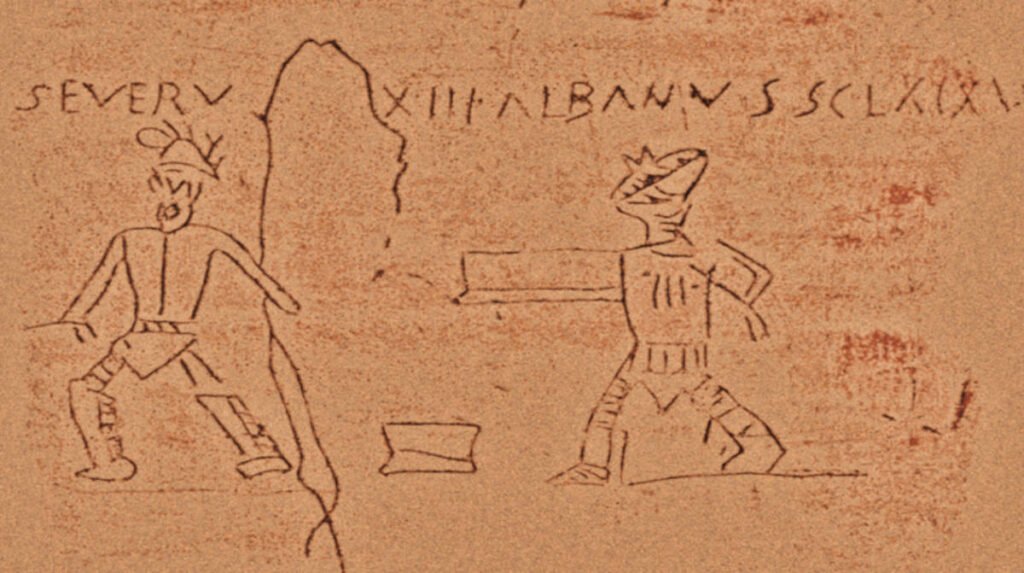[ad_1]
Claire Holleran/The Dialog
Ridley Scott’s Gladiator II encompasses a scene by which a senator, seated at a pavement cafe in Rome, reads a printed newspaper. The second has triggered historical past buffs around the globe to wince – the printing press wouldn’t be invented for one more 1,200 years. However the movie additionally depicts a way more genuine type of mass communication within the historic metropolis: writing on partitions.
This contains not solely the formal and well-planned inscriptions proven on buildings and triumphal arches, however the casual scratchings, painted notices and charcoal messages scribbled on the partitions of the town.
- 1,500-12 months-Previous Graffiti reveals Gladiator Battles
- Romans Look to Have Introduced Bedbugs to Britain
The hero of the primary Gladiator movie, Maximus (performed by Russell Crowe in 2000), has his title crudely carved onto his makeshift secret tomb within the Colosseum. Elsewhere his title has been erased from a listing of gladiatorial victors in a parody of damnatio memoriae, the method by which the title and picture of an individual was faraway from public inscriptions and buildings.
That is slightly like the best way the true Emperor Geta (performed by Joseph Quinn) had his title and picture erased from Rome following his homicide by the hands of his brother Caracalla (Fred Hechinger).
Latin-literate viewers could spot a very obscene menace to the emperors – “ irrumabo imperatores” – painted on an exterior wall of Rome within the background of 1 scene. This almost certainly attracts on Roman poet Catullus’s Poem 16, a piece deemed so offensive that it wasn’t even translated into English till the twentieth century.
Whereas the language could appear gratuitous – it roughly interprets as “I’ll orally **** the emperors” – that is exactly the type of vernacular that survives on the walls of Pompeii. Archaeologists have uncovered quotes from the poet Virgil, greetings to mates, tariffs, follow alphabets, the scribbled drawings of youngsters and the doodling of adults. But a lot of the graffiti wouldn’t look misplaced on the again of a bathroom door.
Maybe unsurprisingly, the partitions of Pompeii’s brothel have been a selected hot-spot for sexual graffiti.
One nameless buyer boasts that he had “sc****d many girls there”, however comparable feedback are discovered on the partitions of taverns, bathhouses and within the barely shady space of tombs on the roads simply exterior of Pompeii.
- The Vergilius Vaticanus and How It Survived 1,500 Years
- Unravelling the Roots of Hera, the Wrathful Goddess of Marriage
Erotic graffiti contained in the Lupanare brothel in Pompeii. (Public Domain)
Political Protest
But there was additionally a critical facet to historic graffiti. The plot of the primary Gladiator movie centered on the reminiscence of a democratic Rome that had as soon as been a republic, in distinction to the oppression, cruelty and political intrigue of the town as dominated by Emperor Commodus (Joaquin Phoenix). The Rome of Gladiator II is equally portrayed as one among political unrest. It’s dominated over by two tyrannical brothers, Geta and Caracalla, who’re fully ill-suited to management.
In such circumstances, graffiti may be an essential type of political expression and resistance. In Monty Python’s Lifetime of Brian (1979), Romanes eunt domus daubed on a wall in Jerusalem, is famously parsed by John Cleese’s Roman soldier as “Folks known as Romanes, they go, the home” and corrected to Romani ite domum or “Romans go residence”.
This fictional scene often is the most well-known instance of political graffiti from the Roman world, however there are many real-life situations from historic literature. They point out that graffiti was a longtime means for the individuals of Rome to speak their displeasure concerning the actions of their leaders, writing on partitions, columns and on placards hung across the necks of statues.
Brutus, as an illustration, was inspired to affix the conspiracy towards Julius Caesar by graffiti written in Rome underneath the duvet of darkness. When Emperor Tiberius’ stepson Germanicus died and Tiberius was suspected of getting had him murdered, notices appeared on walls in Rome demanding, considerably unfeasibly, Germanicus’ return.
Within the latter years of Emperor Nero’s reign and at a time of excessive meals costs when individuals should have discovered Nero’s theatrical extra notably galling, mocking graffiti appeared across the metropolis. Emperor Domitian apparently erected so many triumphal arches within the metropolis that somebody wrote “It is enough” in Greek on one among them.
Folks in Rome had each purpose to really feel aggrieved by the actions of Caracalla and Geta, each within the movie and traditionally. The movie variations of the emperors are portrayed as out-of-touch with actuality, residing a lifetime of luxurious and focusing solely on the sector. Caracalla even makes his monkey a consul, an echo of Roman historian Suetonius’ famous claim that Emperor Caligula was planning to bestow the identical honor on his horse.
The historian Cassius Dio paints a picture of the brothers abusing girls and boys, embezzling cash and hanging out with gladiators and charioteers in Rome. Later, Caracalla was ruthless in eradicating any potential threats to his energy, together with Geta and 20,000 of his followers in addition to his personal spouse, Fulvia Plautilla.
The obscene graffiti directed towards Caracalla and Geta in Gladiator II then is a part of an extended custom of political resistance in Rome. The nameless creator undercuts the tyranny and pomp of the emperors by rendering them sexually passive – an insult to their masculinity in a Roman context – and barely ridiculous.
In contrast to the senator sitting exterior the cafe together with his newspaper, the daubing of “ irrumabo imperatores” on a wall of Rome by cowl of darkness is completely plausible.
High picture: Gladiator graffiti in Pompeii. Supply: Mediatus/CC BY-SA 3.0
This text was initially revealed underneath the title ‘Graffiti Was a Powerful Form of Protest in Ancient Rome – as Gladiator II Shows’ by Claire Holleran on The Conversation, and has been republished underneath a Inventive Commons License.
[ad_2]
Source link
